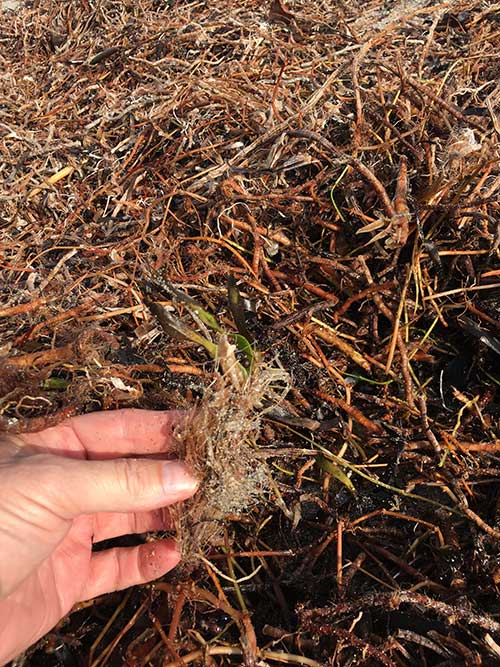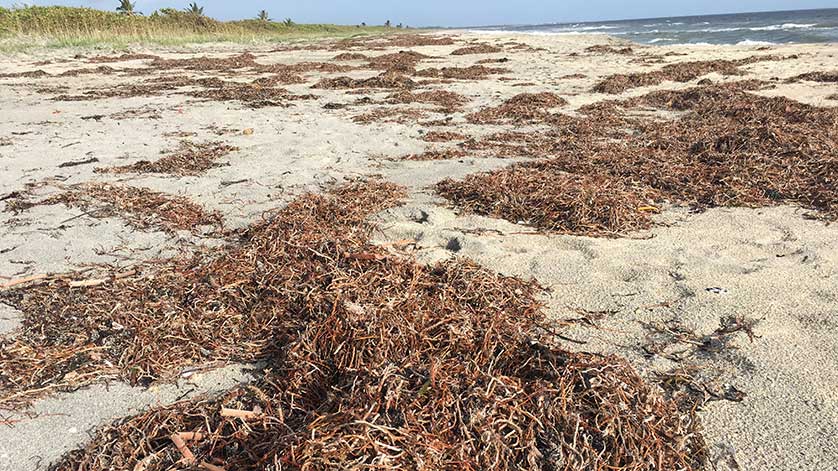Hurricanes Irma and Maria passed over or sent large waves over broad geographic extents of seagrass habitat in Florida, the Caribbean Leeward and Windward Islands and the Bahamas. There have been reports of large rafts of floating seagrass.
In addition, large extents of the Florida east coast have accumulated extensive wrack of not just blades, but the entire rhizome and root system of Thalassia testudinum, Syringodium filiforme and Halodule wrightii (Top Photo), indicating that substantial erosion of seagrass habitat had occurred. T. testudinum rhizomes are the visibly dominant portion of the wrack line.
 Photograph taken Sunday, October 1, 2017 on Jupiter Island at the Hobe Sound National Wildlife Refuge beach access, showing whole Thalassia testudinum short shoot and rhizome wrack. Photo credit: Mark Fonseca.
Photograph taken Sunday, October 1, 2017 on Jupiter Island at the Hobe Sound National Wildlife Refuge beach access, showing whole Thalassia testudinum short shoot and rhizome wrack. Photo credit: Mark Fonseca.
It is not known from where the rhizome mat material on the south Florida east coast originated; it could be comparatively local and from the Florida Keys or Bahamas. However, given the energy and extent of these storms, it may be that some of the material had origins from further into the Caribbean.
The path of the storms also intersected the geographic extent of the invasive Halophila stipulacea (Forssk.) Asch (see reference list, below).
Given the wholesale removal of mature seagrass (T. testudinum) habitat as evinced by the rhizome mats deposited on the Florida east coast, it is conceivable that these extreme events could have mobilized H. stipulacea, which could join with more extensive rafts of native seagrasses. If H. stipulacea were to float independently or raft with other seagrass being transported from the Caribbean to Florida, these extreme events could be a mechanism for the introduction of H. stipulacea to Florida.
There are many qualifiers in this scenario; in particular it is not known if seagrasses now present on the Florida coast originated from within the geographic extent of H. stipulacea. Nonetheless, extreme events have been demonstrated to trigger plant species introductions (e.g., Bhattarai and Cronin 2014). It seems prudent that increased awareness in detecting the presence of H. stipulacea during field surveys of seagrass habitats in south Florida should now be practiced if eradication strategies hope to succeed.
Acknowledgement
Thanks to David Snyder for alerting the author to the presence of the wrack and Amy Uhrin for a quick edit of the text.
By: Mark Fonseca, Vice President, Science at CSA Ocean Sciences Inc.
References Considered
Bhattarai, G. P., J. T. Cronin. 2014. Hurricane activity and the large-scale pattern of spread of an invasive plant species. PLoS One. 9(5): e98478
Maréchal, J.—P., E.H. Meesters, F. Vedie, and C. Hellio. 2013. Occurrence of the alien seagrass Halophila stipulacea in Martinique (French West Indies). Marine Biodiversity Records 6:1- 5.
Rogers, C.S., D.A. Willette, and J. Miller. 2014. Rapidly spreading seagrass invades the Caribbean with unknown ecological consequences. Frontiers in Ecology and the Environment 12:546 – 547.
Ruiz, H., D.L. Ballantine, J. Sabater. 2017. Continued spread of the seagrass Halophila stipulacea in the Caribbean: Documentation in Puerto Rico and the British Virgin Islands. Gulf and Caribbean Research 2: sc5 - 7.
Ruiz, H. and D.L. Ballantine. 2004. Occurrence of the seagrass Halophila stipulacea in the tropical West Atlantic. Bulletin of Marine Science 75:131 - 135.
Steiner, S.C.C. and D.A. Willette. 2015. The expansion of Halophila stipulacea (Hydrocharitaceae, Angiospermae) is changing the seagrass landscape in the Commonwealth of Dominica, Lesser Antilles. Caribbean Naturalist 22:1-19
Willette, D.A. and R.F. Ambrose. 2009. The distribution and expansion of the invasive seagrass Halophila stipulacea in Dominica, West Indies, with a preliminary report from St. Lucia. Aquatic Botany 91:137 - 142.
Willette, D.A. and R.F. Ambrose. 2012. The effects of the invasive seagrass Halophila stipulacea on the native seagrass Syringodium filiforme, and associated fish and epibiota communities in the eastern Caribbean. Aquatic Botany 103:74—82.
Willette, D.A., J. Chalifour, A.O. Dolfi Debrot, M. Sabine Engel, J. Miller, H.A. Oxenford, F.T. Short, S.C.C. Steiner, and F. Védie. 2014. Continued expansion of the trans-Atlantic invasive marine angiosperm Halophila stipulacea in the eastern Caribbean. Aquatic Botany 112:98—102.



